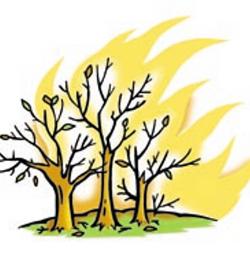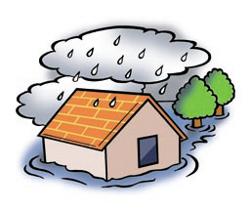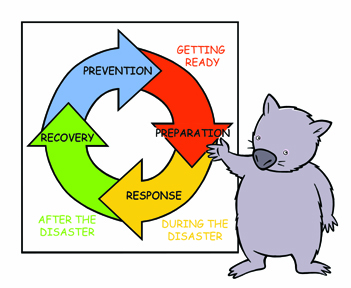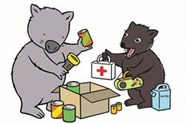Diary Chapters
On Alert
Wise Words
Many hands make light work!
Extreme weather can be
unpredictable and dangerous. The best thing we can do is learn
about emergency situations and know what to do.

RING OF FIRE
Our planet's crust is made up of different pieces, called
'Tectonic
Plates'. Some plates stretch underneath whole continents and
other plates join underneath the ocean.
The Pacific Plate is located on the edge of the Ring of Fire - a
horseshoe shaped arc that stretches from New Zealand up around Asia
and the Pacific. You can watch a ABC Behind the News episode about
the Ring of Fire here!
Inside the arc is a hot bed of sleeping and active volcanoes.
90% of the world's earthquakes are within the Ring of Fire. Find
out more about the volcanoes in Australia on this website.
WHAT'S THE DIFFERENCE: WEATHER AND CLIMATE?
Weather is around us all of the time. It is the day
to day conditions of a place. Rain, temperature, fog, snow, clouds,
sunshine are all elements of the weather. Someone who studies
weather and makes weather forecasts is called a meteorologist.
Climate is the average weather conditions measured
over time. Australia has a hotter climate than Alaska.
Climatologists are people who study climate patterns and climate
change over time.
Find out here why health professionals are
so worried about climate change's relationship to weather impacts
and how they can affect our health!

OUR WILD WEATHER
Cyclones, floods, bushfires, earthquakes, serious storms and
tsunamis are part of nature. They are unpredictable and can be very
dangerous. Climate change has the potential to make some types of
extreme weather more frequent, while others may become more
intense. This is a complex area of science that we still have lots
to learn about. Other than becoming a Extreme Weather Hero (when you're
old enough), the best thing you can do is learn about the disasters
and know what to do. You can tick off the things you can do to
prepare using this handy check-list or check out the games
on this page!
RECENT DISASTERS
2011: QLD/NSW/VIC flood (covered more land than
Germany and France combined!), Japan earthquake and tsunami,
Cyclone Yasi, Christchurch earthquake
2009: Black Saturday bushfire in Victoria
2006: Cyclone Larry, QLD
2002-06: Drought in South Australia
Make a video to explain to other kids how to be prepared for
extreme weather. Interview an expert to help tell the story.You can
use the resources on the Red Cross website to see what to
prepare!
On average, an earthquake of Richter magnitude 5.5 (almost the
size of the Newcastle event in 1989) occurs every 15 months in
Australia.
Heat waves are very dangerous to Australians and cause the most
loss of life for people and animals in comparison to other natural
disasters each year.
Albuera Street Primary, TAS
The Albuera Green Team are a group of students who
love the planet. We particularly loved the Grow N Gobble
garden and canteen, what a wonderful idea! Albuera Street Primary
teaches every aspect of food preparation from where our food comes
from. The Mooster Chef competition saw each class will take
turns in planning, preparing and serving a healthy lunch item and
an after school snack using dairy and sustainable food practices.
Here they are now with a quick message
Find out about a volunteer organization in your area. You can
have a look here. Then invite a representative
to come and speak to you about what you can do to help in the case
of a disaster.
LEARNING FOR THE FUTURE
In 2011, an earthquake and resulting tsunami destroyed a nuclear
power plant in Fukushima, Japan. The land around the power plant,
as well as food and water supplies, were badly contaminated.
Nuclear power companies around the world took the opportunity to
learn from the disaster and have taken major steps to improve their
safety procedures. However, there's a huge amount of work to be
done to rebuild the community and some people do not think nuclear
energy is safe. What do you think?
Stuff to Check Out
BUILD IT BACK GREEN
Each time a city is damaged by a natural disaster,
we learn more about the materials we need to
rebuild the city so it can withstand the pressures
of extreme events and use less energy, water and
waste. After the bushfires in Victoria and Western
Australia, the cyclones in Queensland and the
floods around the nation, we are getting better at
building back green so our buildings are more
sustainable and can cope better with future disasters.
Do
some research and find out how we can build
things sustainably!
HANDS ON!
Sign
up for 'Witness King Tides' and join mum, dad or friends to
take some photos when big tides hit our coasts.
BUILD YOUR OWN DISASTER KIT
If you had to survive for a few days without clean water, food
or clothes, what would you need? Try this fun online game which
allows kids to find the everyday items they need to have in a
disaster supply kit. What are you waiting for? Go ahead and build your
own disaster supply kit!
ADULT ALERT! WHAT THEY ARE DOING
TO HELP.
When disasters occur EVERYONE pitches in - volunteers,
firefighters, neighbours, leaders, builders, teachers. We plan for
events so we know what to do if they happen. Plans are created to
deal with prevention (stopping disasters), preparation (getting
ready), response (during the disaster) and recovery (after the
disaster).

PREVENTION
* Clearing leaf litter from drains
- * Laws for total fire ban days
- * Building flood levees
- * Warning systems
PREPARATION
* Telling people and evacuation
* Protecting property and animals
* Arranging supplies
RESPONSE
* Arranging accommodation for people
* Arranging relief funds
RECOVERY
* Clean up
* Rebuilding
* Support for people affected
|
WHAT YOU CAN DO
- Talk with your family about what to do in case of an emergency.
How would you respond if you knew a flood, cyclone or fire was
nearby?
- Find out where to take shelter in a storm. At home, it'll be
the strongest part of your house and the room with fewest windows.
The local hall or school might turn into an Evacuation Centre.
- Take care of your pets. Plan how you will transport them to
safety, make sure they
 are vaccinated and prepare
pet evacuation kits. are vaccinated and prepare
pet evacuation kits.
- Make up an Emergency Supplies Kit with food, a first aid kit,
safety equipment and contact numbers.
- Make sure you stay up to date with the weather
forecast to see any early warning signs.
- Know who to call for help. For the State Emergency Service
(SES) call 132-500, for police and emergency services call
000.
- Pack up your special things to keep them safe.
- Print this checklist and go through it with
your family.
|
SOCIAL NETWORKING POWER_103x103.jpg)
Communication has proven to be ESSENTIAL in responding to
disasters and extreme weather. Once the electricity is cut off,
people can become very isolated and are unable to find out what's
happening and where to go for safety. AM radios and mobile phones
are definitely essential items for your emergency kit. Social
networking sites such as Facebook and Twitter were valuable sources
of information to help people respond and recover during the 2011
natural disasters.